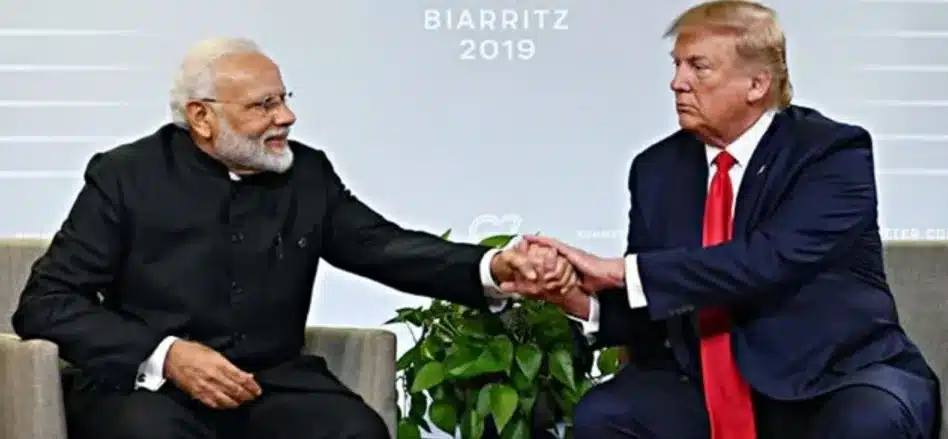What’s in today’s article?
- Why in News?
- 59th All India Conference of Director Generals/ Inspector Generals of Police
- Key highlights of the speech delivered by PM Modi
Why in News?
Recently, US President-elect Donald Trump has threatened the BRICS nations (Brazil, Russia, India, China, South Africa) with 100% tariffs if they create a new currency or support an alternative to the US dollar as the global reserve currency.
Trump stated that any attempt to undermine the dollar’s dominance would result in economic retaliation, asserting that the US economy will not tolerate such moves.
Why countries all over the world are trying to replace US Dollar?
- Weaponization of the Dollar:
- The US has increasingly used its financial dominance as a geopolitical tool by imposing sanctions and cutting off countries like Iran and Russia from systems like SWIFT.
- Society for Worldwide Interbank Financial Telecommunication (SWIFT) is key to international financial transactions.
- This has raised concerns about the dollar being used as a weapon against sovereign nations.
- The US has increasingly used its financial dominance as a geopolitical tool by imposing sanctions and cutting off countries like Iran and Russia from systems like SWIFT.
- Reducing Dependence on the US
- The US dollar remains the dominant global currency, accounting for 88% of global forex turnover (BIS 2022).
- Relying on the US dollar makes countries vulnerable to US monetary policies, which are primarily designed for the American economy but can have global repercussions.
- For instance, rising US interest rates can strengthen the dollar, causing capital outflows and economic instability in other countries.
- Economic Sovereignty
- Nations wish to reduce external influence on their financial systems. By de-dollarizing, they aim to shield their economies from fluctuations in the dollar and from US political pressures.
- Trade Efficiency:
- Regional and bilateral trade agreements often promote settling trade in local currencies or alternatives like China’s yuan or regional payment mechanisms, bypassing the dollar altogether.
- Rise of Multipolarity:
- With the global balance of power shifting, emerging economies like China, India, and Brazil are advocating for a more decentralized financial order that reflects the multipolar nature of the modern world.
- US Debt and Inflation
- The US’s growing debt levels and inflationary pressures have raised concerns about the long-term stability and purchasing power of the dollar, prompting countries to explore alternatives.
- Avoiding Transaction Costs
- Conducting trade in the US dollar often involves high transaction and conversion costs. Using local currencies or regional alternatives can reduce these expenses.
Internationalisation of the rupee
- About
- Internationalisation of the rupee is a process that involves increasing use of the local currency in cross-border transactions.
- Basically, it is a process of promoting and increasing the use of the INR as a widely accepted currency for international transactions and investments.
- Steps taken to promote international trade settlement in rupees
- In July 2022, the RBI has provided an additional arrangement for invoicing, payment, and settlement of exports/imports in the rupee.
- As part of this mechanism, in December 2022, India saw its first settlement of foreign trade in rupee with Russia.
- So far banks of more than 19 countries including the UK, New Zealand, Germany, Malaysia, Israel, and the United Arab Emirates have been permitted to make settlements in rupees.
- Challenges
- Rupee not a dominant currency
- The rupee constitutes only 1.6% of global forex turnover.
- For the rupee to be recognized as an international currency, its turnover must rise to 4%, equivalent to other non-US, non-Euro currencies.
- Challenges in India-Russia Trade in Rupees
- US Sanctions Fear: Indian banks are cautious about facilitating trade in rupees due to potential US sanctions.
- Trade Imbalance: India’s imports from Russia ($61 billion in FY24) vastly outweigh exports ($4.2 billion), resulting in Russia holding large rupee reserves. These reserves are underutilized in trade and are instead invested in Indian stocks and bonds.
- Lessons from Russia-China Trade in Domestic Currencies
- Over 90% of their $240 billion bilateral trade in 2023 was settled in roubles and yuan.
- This is due to their more balanced trade relationship and reduced dependence on the US dollar.
- India is not trying to target the US dollar
- India is looking for alternative settlement mechanisms when trade partners face dollar shortages, to ensure continued trade without hostility towards the dollar.
- Rupee not a dominant currency
Potential Risks of imposing 100% Tariffs on BRICS Nations
- Experts argue that imposing 100% tariffs on BRICS nations could backfire:
- Imports into the US would simply shift to third countries, potentially increasing costs for American consumers without bringing manufacturing jobs back home.
- The US has become less competitive in manufacturing labour-intensive goods due to higher production costs, and tariffs are unlikely to reverse this trend.
What should be the way forward?
- Need for Balanced Currency Frameworks in BRICS
- Experts emphasized that India should ensure BRICS currency initiatives do not disproportionately favor China due to its economic dominance.
- India’s Strategic Approach
- India must take a balanced approach:
- Diplomatic Engagement: Explain to the US that diversifying trade mechanisms promotes financial stability and is not anti-American.
- Leadership in BRICS Initiatives: Accelerate the internationalization of India’s digital currency (CBDC) and financial platforms like UPI to assume a leadership role.
- India must take a balanced approach:
- Conclusion
- India must balance its participation in BRICS financial reforms with strategic ties to the US while ensuring frameworks do not favor China.
- The global financial system shows diversification, but the US dollar remains dominant, with gradual shifts toward non-traditional currencies.
Q.1. Why is the US dollar losing its dominance globally?
The US dollar faces challenges due to geopolitical sanctions, the desire for economic sovereignty, and rising alternatives like regional currencies. Countries aim to reduce reliance on US monetary policies and protect against economic instability.
Q.2. What are the risks of imposing 100% tariffs on BRICS nations?
Imposing 100% tariffs could increase US consumer costs, shift imports to third countries, and not revive manufacturing jobs. Higher production costs make US manufacturing less competitive, making tariffs ineffective in reshoring production.
News: Trump threat to BRICS over ditching the dollar: what he can do, what it will mean for US, India | Times of India
Last updated on December, 2025
→ Check out the latest UPSC Syllabus 2026 here.
→ Join Vajiram & Ravi’s Interview Guidance Programme for expert help to crack your final UPSC stage.
→ UPSC Mains Result 2025 is now out.
→ UPSC Notification 2026 is scheduled to be released on January 14, 2026.
→ UPSC Calendar 2026 is released on 15th May, 2025.
→ The UPSC Vacancy 2025 were released 1129, out of which 979 were for UPSC CSE and remaining 150 are for UPSC IFoS.
→ UPSC Prelims 2026 will be conducted on 24th May, 2026 & UPSC Mains 2026 will be conducted on 21st August 2026.
→ The UPSC Selection Process is of 3 stages-Prelims, Mains and Interview.
→ UPSC Result 2024 is released with latest UPSC Marksheet 2024. Check Now!
→ UPSC Prelims Result 2025 is out now for the CSE held on 25 May 2025.
→ UPSC Toppers List 2024 is released now. Shakti Dubey is UPSC AIR 1 2024 Topper.
→ UPSC Prelims Question Paper 2025 and Unofficial Prelims Answer Key 2025 are available now.
→ UPSC Mains Question Paper 2025 is out for Essay, GS 1, 2, 3 & GS 4.
→ UPSC Mains Indian Language Question Paper 2025 is now out.
→ UPSC Mains Optional Question Paper 2025 is now out.
→ Also check Best IAS Coaching in Delhi

















